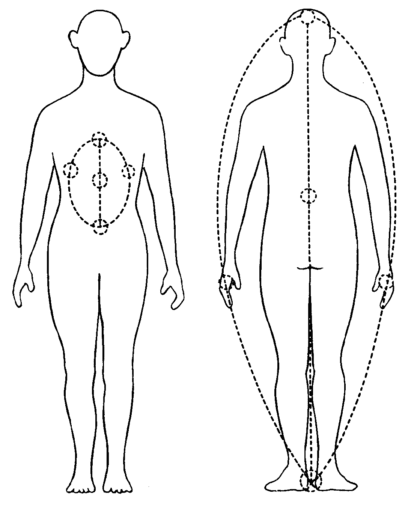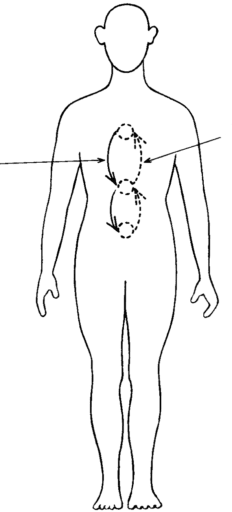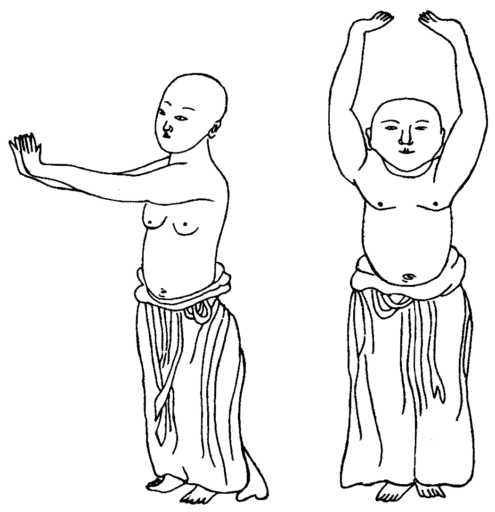
Breathing is accepted as the most natural thing in the world, but very few people really consider how important to the body correct breathing is. We can all go without food and water for many days, yet, if we stop breathing for even thirty seconds, we quickly realize that we cannot do without air for even a short while. Yes, we accept breathing without ever giving it a serious thought, unless we have the misfortune to suffer a complaint such as hay fever, asthma or emphysema when breathing becomes really difficult.
Through bad habits or ignorance, the majority of people breathe very shallowly, using only about one-third of their lung capacity on each breath intake. Owing to this, their health is likely to deteriorate — fatigue, sluggishness, tiredness, headaches, bronchial complaints, wheeziness in the throat, and so on, becoming the order of each day for them. Lack of oxygen can throw an undue strain on the heart and create many circulation problems, which in turn will affect the tissues and bone structure, decrease sexuality, and affect the glands, the whole nervous system, and all internal organs.
Let us look at one or two of the complaints that people may suffer from mainly owing to poor or inadequate breathing.
Emphysema, a complaint that is now widespread, though virtually unknown before the turn of the century, has now increased, and every day sees an increase in the numbers that are suffering from this simple complaint. What happens is some of the tissues within the lungs dilate and become fused together, cutting down the surface area, and thereby causing the breathing to become more rapid. This throws an added burden on to the heart, which may fail if subjected to too great a strain.
Bronchitis, which is accompanied by a persistent bad cough, is generally the result of bad eating habits and too much fluid within the body. By correcting the diet and learning to breathe deeply and correctly, this simple Yin complaint can be eliminated.
Asthma can readily be recognized by the laboured breathing of the sufferer. It is caused by overworking of the kidneys and can be cured by breathing properly and limiting the fluid intake.
Many other illnesses too, including tuberculosis, pneumonia, hay fever, pleurisy and sinus trouble, are caused by bad eating habits and insufficient oxygen in the bloodstream. When our lives depend so much on correct breathing, it is clearly imperative that we should learn to breathe properly, so that we are constantly in good physical condition and therefore in good health.
It is very important, at all times, to have sufficient fresh air entering the lungs, so that the impure blood in the body can be cleansed and purified through the action of the oxygen coming into contact with the blood within the lungs. If this purification does not take place, then waste products re-enter the bloodstream and the blood deteriorates, causing a general weakening of the body. Energies become depleted, making the body less resistant to illness and disease, and causing fatigue, which is the commonest cause of ill health. Learn, therefore, to breathe deeply every minute of the day, and eat and drink the Ch’ang Ming way, as described in the previous chapter. Correct and controlled breathing helps to open the channels to the psychic centres, revitalize and re-energize the body, and so open the way to the mind and spiritual development.
In the Chinese art of K’ai Men there are twenty basic specialized breathing exercises: eight Yin, eight Yang, and four a mixture of the two. Each of these has a specific job to do — some of them acting as a sedative, some as a tonic, and some assisting with the harnessing, activation and cultivation of the internal and macro-cosmic energies, and opening up the functional and control channels that feed and activate the energy and psychic centres within the anatomy.
There are two main ways of breathing, and these are each divided into two halves, each of which has three centres. The two main ways are Yin and Yang, but these each contain something relating to the other, as will be outlined below.
Yin
Yin breathing is very shallow breathing indeed, and is the way that most people usually breathe. It is very unhealthy and is the cause of many chest, throat and head ailments. It raises the upper chest, shoulders and collarbone when an in-breath is taken, and is generally known as clavicular breathing. Because it causes pressure against the diaphragm, the lungs get very little air, and this means that the benefit to the blood and the body as a whole is very slight
One of the variants of Yin breathing involves inhaling strongly and for longer than you exhale for, but be careful if you attempt this: it causes a very light sensation within the upper chest and head, and may make you feel a little dizzy. This is because Yin breathing stimulates the mid-brain, and increases the amount of energy attracted from the earth.
The Yin Micro-cosmic Orbit, or Inner Ch’i Circling, is another of the specialized Taoist techniques. By breathing deeply through the lower abdomen (Tan T’ien — the Lower Cauldron or Stove) — and using special arm movements in cooperation with a partner, the student can learn how to lock his internal energy or vitality power into the five positions indicated on Diagram 1.
The Yang Macro-cosmic Circle, Yin section, or Outer Ch’i Circle, is a dynamic breathing exercise that requires many years of practice at K’ai Men before it can even be attempted. This is because it demands a very strong Ch’i action, a dynamic depth of concentration within oneself, and positive mind control. The basic principle of the technique (see Diagram 2) is to breathe without taking an in- or out-breath (as usually understood), and it is accomplished through the soles of the feet, the middle of the spine and the top of the head. The internal energy is circled through these points and also out to the finger-tips. Only students who have spent many years practising all aspects of K’ai Men will fully appreciate what this means and how it is accomplished.
Yang

Diagram 1
Yin Micro-cosmic Orbit, Yin section
Diagram 2
Yang Macro-cosmic Circle, Yin section
Yang breathing is very deep breathing because it concentrates on the utilization of the diaphragm. In the West it is generally known as diaphragmatic breathing. This way of breathing gives greater freedom to the lungs and so their absorption becomes more, but, because of the downward pressure on the abdominal organs, which gives them an internal massage, the abdomen is pushed outward. All this is stimulating to the lower abdomen and increases the amount of energy attracted from heaven.
Another Yang way of breathing is to make your in-breath short and sharp, but exhale strongly and for as long as you can. This method of breathing is the best for your health, for it helps to generate enormous energy, gives the blood all the oxygen that it needs, purifies the blood by the absorption of waste matter, and helps to strengthen the nervous system and give health to the rest of the anatomy.
The Yin Micro-cosmic Orbit, Yang section, combines the vitality power, or internal energy, with macro-cosmic energy. Through specialized breathing techniques these energies are raised as shown in Diagram 3: from point A up the spine to point E, at the top of the head. Both energies can be locked into the positions marked B, C, D, and E on the diagram, and these are known as the channels of control, which not only give positive and dynamic energy to the body and mind, but also vibrate the psychic centres and open up and strengthen the channel to the spirit.
Diagram 3 Yang section: Yang Macro-cosmic circle and Yin Microcosmic Orbit
Yang Macro-cosmic Circle

Yin Micro-cosmic Orbit
The Yang Macro-cosmic Circle in the Yang section is the completion of the entire circle, from point E back to point A, through F, G, and H, and after completion of the full circle the energies are controlled back to the lower abdomen or lower cauldron, where they are harnessed and revitalized. The openings from point E down the front of the body to point A are known as functional channels, and they are used to control the external use of the vitalities forces, for health and spiritual purposes. If you can get this far, then you are on your way to spiritual immortality through Taoist alchemy.
Yin/Yang
This is a series of breathing exercises whereby the in-breath is as strong and takes as long as the out-breath. This style of breathing attracts energy from both heaven and earth, in equal measure. (See Diagram 4.)
Diagram 4 Yin/Yang section: Yang Macro-cosmic Circle and Yin Micro-cosmic Orbit
Yang Macro-cosmic Circle

Yin Micro-cosmic Orbit
The Yin Micro-cosmic Orbit, Yin/Yang section, consists of raising the breath and internal energy from the lower abdomen to the solar plexus and then driving it downward back to the abdomen. Placing one’s hands on those two spots aids the circling of the energy, and also helps to vibrate and pulsate the psychic centres that are there.
The Yang Macro-cosmic Circle, Yin/Yang section, consists of lifting the breath and the internal energy through three levels, from the lower stomach, into the solar plexus and then into the heart, and then gently lowering them back through the same centres until they rest again in their natural home, the lower abdomen.
In addition to the twenty basic breathing sequences in Taoism, there are many more, linked with physical movements and exercises. This makes the breathing and energy section of K’ai Men the most comprehensive and dynamic exploitation of the human body, the functions and vibrations of the psychic centres, the control channels to, from and within the mind, and the subconscious. The harmony of all opens the door to the spirit.
The importance of breathing is greatest at the beginning ana end of your earthly life. Did you know that the first thing a baby does at birth is exhale, and that the last thing a dying person does is inhale? In the latter case, the pressure that has been built up by inhalation acts on the weakness of the heart and brings death.
All deep breathing brings about a harmony of Yin and Yang vibrations and pulsations, so learn to breathe deeply all the time, day in and day out, and utilize your full lung capacity, so that the body can obtain the maximum benefits. The various forms of healing in K’ai Men — meridian healing, Ch’i healing, breath healing, sound healing, meditation healing, Chinese push and pull massage, spot pressing and so on — are all founded upon the effective use of vibrations and pulsations.
In K’ai Men, great emphasis is placed on correct and total breathing — irrespective of the type of breathing exercise being executed — and upon maintaining complete breath control at all times. All physical exercises in K’ai Men are split into two sections: the “sequence”, in which deep breathing is of particular importance; and the “extension”, in which full and constant mind and body control are the speciality.
Regulated breathing under strictly controlled conditions will enable you to learn how to drive your breath downwards to the lower abdomen, so arousing the Lower Cauldron or Inner Fire, as it is sometimes known, and activating and pressurising the internal energy held there. This in turn activates that energy so that it is forced up and rises as you inhale. When you exhale this relaxes the diaphragm, which takes the pressure off the lower abdomen, and the internal energy then sinks back to it, down the front of the body.
There follow three different breathing exercises, each of which will in its own way help you internally.
A Yang breath
Diagram 5 Taoist ‘Four-directional’ Yang breathing exercise.
Extracted from the Book of Supple Muscles (Ch’ing Period)

This will give you a great deal of energy and will warm up the whole body, so if you feel cold this is really excellent. It will also help to kill off the bacteria of the common cold and influenza, and will generally tone up the whole system.
- Breathe in through the nose and raise the hands in front of the shoulders as you do so. Exhale slowly but very forcibly through the mouth, as you push slowly but strongly straight forward with the hands, extending the arms.
- Breathe in through the nose and allow the hands to come back in front of the shoulders. Exhale slowly but very forcibly through the mouth, as you push slowly but strongly sideways with the hands, till the arms are fully extended.
- Breathe in through the nose and allow the hands to come back in front of the shoulders. Exhale slowly but forcibly through the mouth, and as you do so push slowly but strongly directly upwards towards the ceiling.
- Breathe in through the nose and allow the hands to come back in front of the shoulders. Exhale slowly but forcibly through the mouth and simultaneously push slowly but strongly downwards, till your arms are fully extended by your thighs.
Now repeat this sequence. You will really feel the benefits.
A Yin breath
This breathing exercise is excellent to do at any time of day, and will help clear the nasal passages and soothe the nerves, and enable the body and mind to relax completely. If you ever feel tense, or under strain, or think a headache is coming on, then try this exercise.
You can sit down to do this exercise. Rest your right elbow on a table, and place the index finger of your right hand on your forehead, between your eyebrows (if you are left-handed, substitute left for right throughout the exercise).
Now press your right thumb against your right nostril so as to close that nostril completely. Slowly inhale through your left nostril until you have filled your chest as much as you can, and then exhale just as slowly through the same nostril until all the air has gone.
Now free your right nostril and press the middle finger of your right hand against your left nostril, so as to close it. Slowly breathe in again, filling your lungs and chest, and then slowly and completely exhale.
These two movements comprise the full sequence, and if you repeat it five times you will find it very relaxing indeed; but ensure that the breathing is done continuously and that there is no time lag in changing from thumb and middle finger or vice versa.
A Yin/Yang breath
This exercise is excellent for the activation of energy and vibrates three psychic centres, which in turn revitalize the whole of the anatomy and mind.
Make yourself comfortable either by sitting in a chair or, better still, by sitting on the floor with your legs crossed. Keep the body upright, but do not hold it too stiffly. Place your right hand on your lower abdomen, and your left hand on the solar plexus — in both cases, directly on the skin.
- Now breathe in through the nose, but breathe deeply, so that the downward pressure pushes your right hand outward. Then press with your right hand on your lower abdomen so that the air is forced upward into the area of the solar plexus.
- Press with your left hand, so that the air is forced to rise up into the chest.
- Slowly exhale through the nose, allowing the chest to collapse.
- Press your left hand on the solar plexus so that all the air there is pushed out.
- Press with your right hand, so that all the air remaining in the lower abdomen is expelled.
Don’t forget to breathe as deeply as you possibly can, and endeavour to do a minimum of six in- and out-breaths, following the above sequence.
- Learn to breathe — and you will live.
- Learn to breathe well — and you will retain good health.
- Learn to breathe deep — and you will attain longevity.
- Learn to breathe inwardly, without breathing —and you will gain spiritual immortality.
- Follow the Taoist advice, now and always.

From The Taoist Art of Kai Men
by Chee Soo
